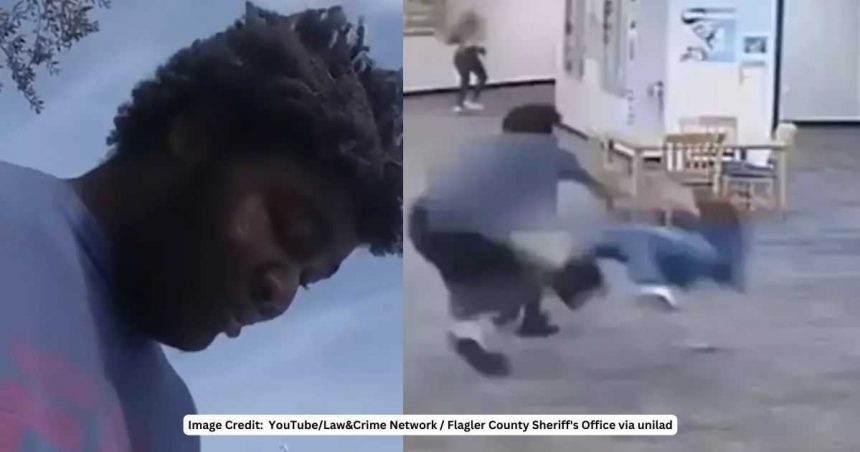In a shocking series of events that sent shockwaves through Matanzas High School and beyond, a seemingly ordinary school day took a dark turn into a grave incident that left a community grappling with its aftermath. At the center of this turmoil is 18-year-old Brendan Depa, whose actions on that fateful day not only resulted in severe legal repercussions but also sparked a contentious legal battle against the institution that was supposed to provide him with support. This case raises important questions about the intersection of education, behavioral challenges, and legal accountability.
As we delve into the layers of this complex situation, we uncover crucial details and broader implications that may reshape how educational systems support students with special needs. Join us on this riveting journey as we unravel the events that led to a lawsuit with far-reaching consequences for schools nationwide.
The Incident Details
On an average school day in February 2023, the tranquility of Matanzas High School was shattered by a disturbing act of violence that soon made national headlines. Brendan Depa, a 17-year-old student at the time, launched an unprovoked attack on Joan Naydich, a paraprofessional at the school. The brutal incident, captured on CCTV, showed Depa aggressively confronting Naydich and ultimately shoving her to the ground where she lay unconscious.
As the situation escalated, Depa proceeded to kick and punch the defenseless aide, a sight that was both shocking and heart-wrenching. This violent outburst was not an isolated moment of rage but hinted at deeper underlying issues. The footage of the attack quickly went viral, triggering widespread outrage and shining a spotlight on the circumstances that led to such a breakdown in the supposed safety of the educational environment.
Depa was initially charged in juvenile court, but the severity of the attack—categorized as aggravated battery causing bodily harm—led authorities to upgrade the charges to a first-degree felony. This legal escalation reflected the gravity of the injuries inflicted on Naydich, which included severe physical trauma. As the case unfolded, it became evident that the legal system was grappling with a multifaceted blend of juvenile justice and the urgent need to address the behavioral and educational deficiencies that may have contributed to the incident.
This event not only raised questions about the adequacy of support systems for students with special needs but also sparked a debate on the appropriateness of elevating juvenile charges to adult levels in cases involving individuals with significant mental and behavioral challenges.
Legal Charges and Response
Following the violent incident at Matanzas High School, Brendan Depa faced serious legal consequences. At 17, Depa was charged as an adult with first-degree felony aggravated battery, a charge carrying significant potential penalties. This charge mirrored the severity of the assault on Joan Naydich, a paraprofessional at the school, which was captured in distressing detail on school security cameras.
The legal proceedings for Depa have been intricate and plagued with delays. After entering a plea of no contest to the charges, the sentencing was initially set but has since been postponed to allow more time for preparation by his defense team. This delay was partly due to the unavailability of expert witnesses crucial to Depa’s defense, including assessments of his mental health and capacity to stand trial. These assessments are pivotal given Depa’s autism diagnosis and the implications it may have on his comprehension and intent during the incident.
The court’s management of Depa’s case has drawn attention to several issues, including how the justice system handles cases involving young defendants with significant mental health challenges. The presiding judge has a range of sentencing options, with the potential for a minimum of just under three years to as much as 30 years in prison, depending on various factors, including Depa’s mental health evaluation and the specifics of the incident.
The Lawsuit Against the School District
In a dramatic response to the troubling incident at Matanzas High School, Brendan Depa, through his legal representatives, has initiated a lawsuit against Flagler County Public Schools. This legal action asserts that the school district grossly neglected its responsibilities towards Depa, particularly in failing to address his well-documented behavioral and educational needs.
Depa’s lawsuit argues that the school failed to take adequate steps to manage his behavior, which was known to escalate under certain conditions, notably regarding the use of his Nintendo Switch—a device identified as a trigger for his aggressive outbursts. The legal claim outlines several instances where the school’s interventions—or lack thereof—were insufficient, despite clear warnings that Depa could be a ‘ticking time bomb’ under specific circumstances. The complaint details how Depa’s aggressive behaviors, such as running away, disregarding directives, and physical aggression, were met with temporary suspensions rather than substantial behavioral interventions or consistent strategies to effectively manage or mitigate these actions.
The lawsuit additionally criticizes the school for failing to adhere to Depa’s Individualized Education Program (IEP), which contained specific recommendations tailored to his needs, including the necessity for consistent handling of situations involving his triggers. The family argues that these failures not only contributed to the violent incident but also exacerbated Depa’s ongoing behavioral and psychological challenges.
Seeking legal recourse, Depa’s family aims to hold the district accountable for its purported failures in providing an appropriate educational setting and necessary behavioral supports, as mandated under federal law. They seek not only a change in Depa’s educational placement to a more suitable environment but also compensation for the damages and legal costs incurred due to the district’s alleged negligence.
This lawsuit raises significant questions about the obligations of educational institutions to adequately support students with special needs and ensure their behavior is managed in a way that does not lead to harmful outcomes.
Education and Behavioral Challenges
Brendan Depa’s educational and behavioral challenges are central to understanding the complexities of his case. Diagnosed with autism and several other mental health issues, Brendan’s condition significantly impacted his behavior and responses to stressful situations. His educational journey at Matanzas High School was marred by significant difficulties, particularly in relation to his behavioral management.
The school’s failure to accommodate his needs effectively is a critical aspect of the lawsuit filed by his family. Brendan’s Individualized Education Program (IEP) contained specific directives crucial for managing his behavior, including guidelines for handling his access to electronic devices like the Nintendo Switch, a known trigger for his aggressive episodes. Despite this, the lawsuit alleges failures in consistently implementing these measures, leading to the tragic incident.
Furthermore, Brendan’s behavioral challenges were compounded by medications prescribed to manage his condition, which often had significant side effects and failed to yield intended results. His mother, in discussing his care, highlighted the struggles in finding suitable medical treatments, which frequently changed and had unpredictable impacts on Brendan’s mental and emotional well-being.
Moreover, legal assessments of Brendan’s mental competency to stand trial revealed that while he may understand certain aspects of his situation, he had a limited grasp of the severity of the charges against him or the implications of the legal proceedings. This raises important considerations about the justice system’s handling of individuals with significant cognitive and behavioral challenges.
The case of Brendan Depa not only sheds light on the individual challenges of a young man with severe autism but also underscores broader issues related to educational and behavioral support for students with special needs. It serves as a poignant reminder of the critical need for schools to have robust systems in place to adequately support such students and prevent such incidents from occurring.
Arguments from Depa’s Legal Team
Brendan Depa’s legal defense has revolved around the argument that the school district failed to provide the necessary support and interventions required to manage his behavioral needs effectively, stemming from his autism and related conditions. This failure, they contend, directly contributed to the circumstances leading to the assault on the school paraprofessional, Joan Naydich.
Depa’s attorneys argue that the school district was well aware of his triggers and the specific requirements outlined in his Individualized Education Program (IEP) but failed to implement these adequately. For example, inconsistent policies regarding the use of his Nintendo Switch, a known trigger for Depa’s aggressive behavior, were not managed according to the stipulations of his IEP. The legal team asserts that this lack of consistent application of behavioral management plans contributed to the escalation that culminated in the assault.
Moreover, the…






